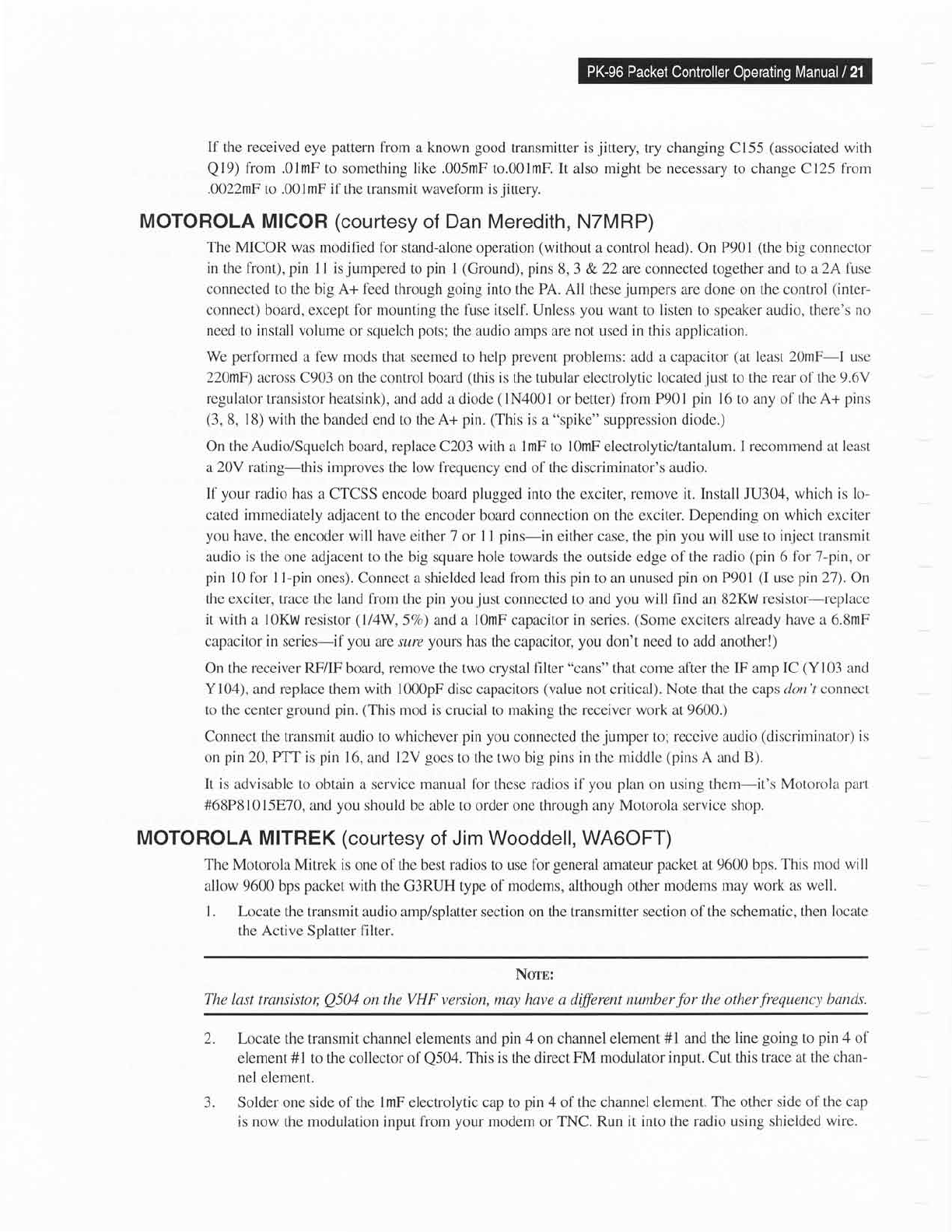Specifications
Table Of Contents

If the received
eye
pattern
from a known
good
transmitter is
jittery,
try changing
C155
(associated
with
Ql9)
fiom .0lmF
to something
like
,005mF to.00lmF. It also might be necessary to change Cl25
from
.0022mF to .001mF if the transmit wavefbrm is
jittery.
MOTOROLA
MICOR
(courtesy
of
Dan
Meredith, NTMRP)
The
MICOR was modifred for
stand-alone operation
(without
a control
head).
On
P901
(the
big connector
in
the
fiont), pin
I I is
jumpered
to
pin
1
(Ground),
pins
8,3 &
22
are connected together
and to
a
2A fuse
connected to the big A+ feed
through
going
into the
PA.
All these
jumpers
are done on the control
(inter-
connect)
board, except for mounting the fLrse itself. Unless
you
want
to
listen to speaker audio, there's no
need to install volurre
or squelch
pots;
the audio amps are not used in this application.
We
pertbrmed
a f'ew mods that seemed to help
prevent problems:
add a capacitor
(at
least 20mF-I use
220mF)
across C9O3 on the control board
(this
is the tubular electrolytic located
jr.rst
to the
rear
of the 9.6V
regulator
transistor heatsink), and add a diode
(
1N400 I
or better)
fiorn P901
pin
I 6 to any of the A+
pins
(3,
8,
l8) with
the banded end to the A+
pin.
(This
is a
"spike"
suppression diode.)
On the Audio/Squelch
board, replace C203 with a I mF to I OmF electrolytic/tantalum. I recommend at
least
a
20V
rating-this improves the low fiequency
end of the discriminator's
audio.
If
your
radio has
a CTCSS encode board
plugged
into the exciter, rcmove it. Install JU304,
which is lo-
cated immediately
adjacent to the encoder board connection on the exciter.
Depending
on
which exciter
you
have, the
encoder
will have
either 7 or I I
pins-in
either case, the
pin you
will
use
to inject transmit
audio is the
one adiacent to the big square hole towards the outside edge of
the radio
(pin
6 fbr 7-pin, or
pin
l0
fbr
I l-pin ones). Conncct a shielded lead fiom this
pin
to an unnsed
pin
on P901
(I
use
pin
27).On
the cxciter, trace the land from
the
pin you
just
connected to and
you
will find
an 82KW
resistor-replace
it with a lOKW resistor
(l/4W,57o)
and a lOmF capacitor in series.
(Some
exciters already
have a 6.8mF
capacitor in series-if
you
are
sure
yours
has
the
capacitor,
you
don't
need
to
add another!)
On the receiver RF/IF board, rcmove the two crystal hltcr
"cans"
that come alter the IF amp
IC
(Y103
and
Yl04),
and
replace
them
with
l000pF disc capacitors
(value
not critical).
Note
that
the caps don't connecL
to the center
ground pin.
(This
mod is crucial to making the receiver work at 9600.)
Connect the transmit audio to whichever
pin yor.r
connected the
jLrmper
to; receive audio
(discrirninator)
is
on
pin
20, PTT is
pin
16, and l2V
goes
to the two big
pins
in
the
middle
(pins
A and B).
It is advisable to
obtain a service
manual
lbr these radios if
you plan
on using them-it's
Motorola
part
#68P81015E70, and
you
should
be able to order one through any
Motorola service shop.
MOTOROLA MITREK
(courtesy
of Jim
Wooddell, WA6OFT)
The Motorola
Mitrek is one of the best radios to use fbr
general
amateur
packet
at
9600
bps.
This rnod will
allow 9600 bps
packet
with the G3RUH type of modems, although other
modems may work as well.
1. Locate
the transmit audio amp/splatter section on the transmitter section of the schematic, then
locate
the Active Splatter filter.
Ncnn:
The last transistotr
Q504
on the VHF version, may have a dffirent number
for
the other
freqtten.cy
bands.
Locate the transmit channel elements and
pin
4
on channel
element #1 and the
line
going
to
pin
4
of
element #l to the collector of
Q504.
This is the direct FM modulator
input.
Cut
this trace at the
chan-
nel element.
Solder one side of the I mF electrolytic cap
to
pin
4
of
the channel element.
The
other
side of the cap
is now
the modulation
input from
your
modem
or
TNC. Run it into the
radio
using
shielded wire.
z.
3.










